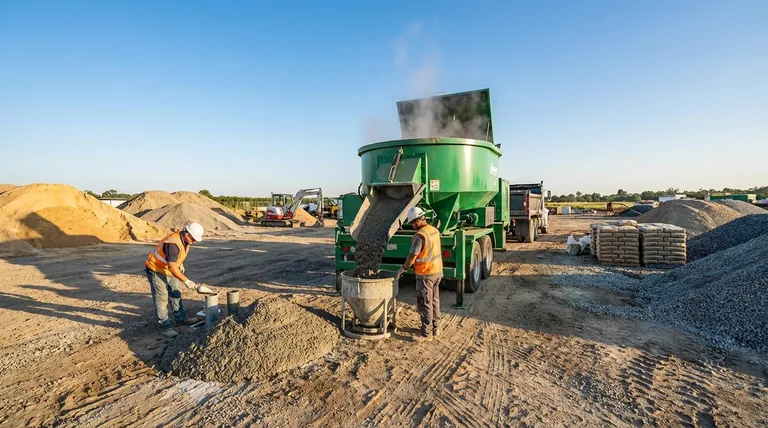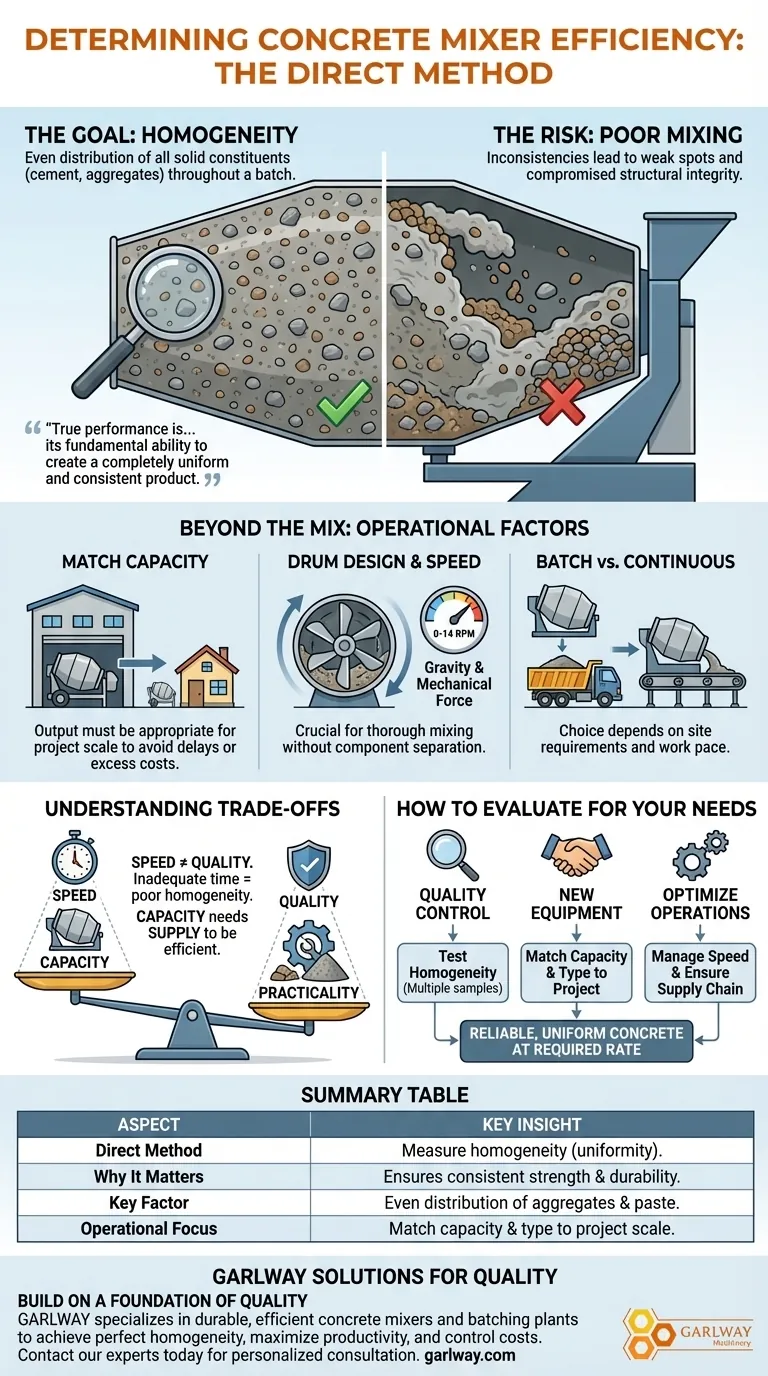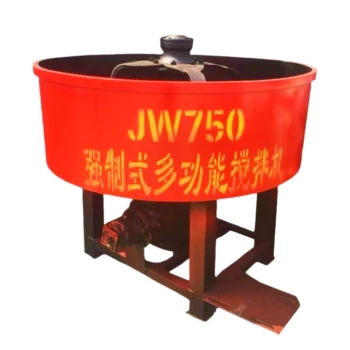The most direct method to determine the efficiency of a concrete mixer is to measure the homogeneity of the concrete it produces. This is achieved by analyzing how evenly the solid constituents—such as coarse and fine aggregates, cement paste, and any mineral admixtures—are distributed throughout a sample batch.
A mixer's true performance is not defined by its speed or size, but by its fundamental ability to create a completely uniform and consistent product. All other operational metrics are secondary to this core function.

What is Homogeneity and Why It Matters
A concrete mixer's primary job is to homogeneously combine cement, aggregates, and water. The efficiency with which it achieves this uniformity directly impacts the final strength and durability of the concrete structure.
The Goal: Uniform Distribution
The mixer must ensure that every part of the batch has the same composition as any other part. This prevents inconsistencies in the final product.
Key Components to Analyze
When testing for homogeneity, you are looking for the even distribution of all key ingredients. This includes the fine aggregates (sand), coarse aggregates (gravel), and the cement paste that binds them together.
The Impact of Poor Mixing
If a mix is not homogeneous, the resulting concrete will have weak spots and inconsistencies. This can compromise the structural integrity, leading to premature failure or reduced lifespan of the construction.
Beyond the Mix: Factors of Operational Efficiency
While homogeneity is the direct measure of mixing efficiency, the overall operational efficiency of a concrete mixer on a job site depends on several other critical factors.
Matching Capacity to Project Scale
The mixer's output must be appropriate for the project's size. Using a mixer with too low a capacity for a large project causes delays, while an overly large mixer on a small project increases unnecessary costs.
The Role of Drum Design and Speed
The physical design of the mixer is crucial. The rotating drum, often inclined and equipped with internal blades, uses gravity and mechanical force to ensure coarse aggregates are thoroughly mixed.
Drum speed, typically between 0 and 14 rotations per minute (rpm), must be managed correctly. The right speed keeps aggregates suspended and promotes a thorough mix without separating the components.
Batch vs. Continuous Mixers
Choosing between a batch mixer (which produces concrete one load at a time) and a continuous mixer (which produces a constant flow) depends entirely on the requirements of the construction site and the pace of work.
Understanding the Common Trade-offs
Evaluating a mixer requires balancing competing priorities. Focusing on one metric, like speed, can negatively impact the most important one: quality.
Speed vs. Quality
Simply mixing faster does not guarantee efficiency. Inadequate mixing time is a primary cause of poor homogeneity, resulting in low-quality concrete regardless of how quickly it was produced.
Capacity vs. Practicality
A large drum capacity is only efficient if your batching plant and material storage can keep pace. An oversized mixer that is constantly waiting for raw materials is a major source of inefficiency.
Manufacturer Claims vs. Real-World Output
The quality of a manufacturer's materials and their reputation are important indicators of durability. However, the ultimate measure of a mixer's efficiency is the proven quality and consistency of the concrete it produces on your site.
How to Evaluate a Mixer for Your Needs
Your evaluation criteria should align directly with your primary goal, whether it's ensuring quality control, purchasing new equipment, or optimizing an existing workflow.
- If your primary focus is quality control and verification: Implement a direct homogeneity testing protocol by taking multiple samples from a single batch to analyze constituent distribution.
- If your primary focus is selecting a new mixer for a project: Prioritize matching the mixer's output capacity and type (batch or continuous) to your project's scale and timeline.
- If your primary focus is optimizing daily operations: Concentrate on managing drum speed correctly and ensuring your raw material supply chain can support the mixer's full potential.
Ultimately, a truly efficient mixer is one that reliably produces uniform concrete at a rate that matches the demands of your project.
Summary Table:
| Aspect | Key Insight |
|---|---|
| Direct Method | Measure the homogeneity (uniformity) of the concrete batch. |
| Why It Matters | Ensures consistent strength and durability of the final structure. |
| Key Factor | Even distribution of aggregates and cement paste. |
| Operational Focus | Match mixer capacity and type to your project's scale and pace. |
Ensure Your Projects Are Built on a Foundation of Quality
A reliable concrete mixer is the cornerstone of any successful construction project. Inconsistent mixing leads to weak spots, safety risks, and costly rework.
GARLWAY specializes in construction machinery, offering durable and efficient concrete mixers, concrete batching plants, and winches for construction companies and contractors globally. We help you achieve perfect batch homogeneity, maximize on-site productivity, and control costs.
Let us help you build with confidence. Contact our experts today for a personalized consultation on the right equipment for your specific project needs.
Visual Guide

Related Products
- Ready Mixer Machine for Construction Ready Mix Machinery
- Commercial Construction Mixer Machine for Soil Cement Mixing Concrete
- Auto Concrete Cement Mixer Machine New
- Construction Products Concrete Plant Machine Mixing Concrete Mixer
- JDC350 Small Cement Concrete Mortar Mixer
People Also Ask
- What should be considered regarding the output of a concrete mixer? Match Capacity to Your Project Scale
- Can a concrete mixer be used for mortar? Understanding the trade-offs for your project
- Why is cleaning a concrete mixer after use important? Avoid Costly Repairs and Ensure Quality
- Which type of projects require a concrete mixer? Essential Guide for Construction Pros
- What is the average lifespan of a concrete mixer? Maximize Your Equipment's Lifespan & ROI



















